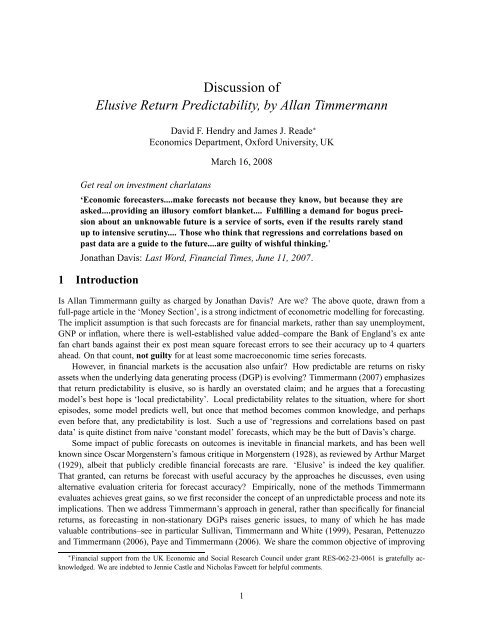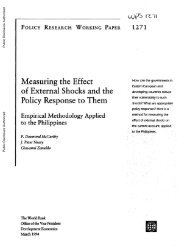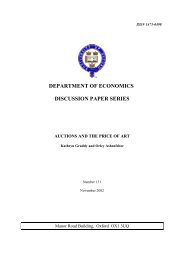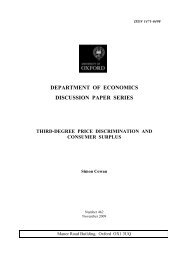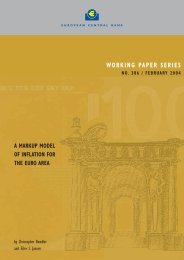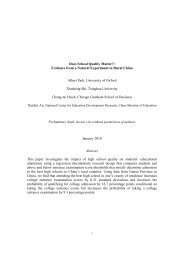Elusive return predictability - University of Oxford
Elusive return predictability - University of Oxford
Elusive return predictability - University of Oxford
You also want an ePaper? Increase the reach of your titles
YUMPU automatically turns print PDFs into web optimized ePapers that Google loves.
Discussion <strong>of</strong><br />
<strong>Elusive</strong> Return Predictability, by Allan Timmermann<br />
Get real on investment charlatans<br />
David F. Hendry and James J. Reade ∗<br />
Economics Department, <strong>Oxford</strong> <strong>University</strong>, UK<br />
March 16, 2008<br />
‘Economic forecasters....make forecasts not because they know, but because they are<br />
asked....providing an illusory comfort blanket.... Fulfilling a demand for bogus precision<br />
about an unknowable future is a service <strong>of</strong> sorts, even if the results rarely stand<br />
up to intensive scrutiny.... Those who think that regressions and correlations based on<br />
past data are a guide to the future....are guilty <strong>of</strong> wishful thinking.’<br />
Jonathan Davis: Last Word, Financial Times, June 11, 2007.<br />
1 Introduction<br />
Is Allan Timmermann guilty as charged by Jonathan Davis? Are we? The above quote, drawn from a<br />
full-page article in the ‘Money Section’, is a strong indictment <strong>of</strong> econometric modelling for forecasting.<br />
The implicit assumption is that such forecasts are for financial markets, rather than say unemployment,<br />
GNP or inflation, where there is well-established value added–compare the Bank <strong>of</strong> England’s ex ante<br />
fan chart bands against their ex post mean square forecast errors to see their accuracy up to 4 quarters<br />
ahead. On that count, not guilty for at least some macroeconomic time series forecasts.<br />
However, in financial markets is the accusation also unfair? How predictable are <strong>return</strong>s on risky<br />
assets when the underlying data generating process (DGP) is evolving? Timmermann (2007) emphasizes<br />
that <strong>return</strong> <strong>predictability</strong> is elusive, so is hardly an overstated claim; and he argues that a forecasting<br />
model’s best hope is ‘local <strong>predictability</strong>’. Local <strong>predictability</strong> relates to the situation, where for short<br />
episodes, some model predicts well, but once that method becomes common knowledge, and perhaps<br />
even before that, any <strong>predictability</strong> is lost. Such a use <strong>of</strong> ‘regressions and correlations based on past<br />
data’ is quite distinct from naive ‘constant model’ forecasts, which may be the butt <strong>of</strong> Davis’s charge.<br />
Some impact <strong>of</strong> public forecasts on outcomes is inevitable in financial markets, and has been well<br />
known since Oscar Morgenstern’s famous critique in Morgenstern (1928), as reviewed by Arthur Marget<br />
(1929), albeit that publicly credible financial forecasts are rare. ‘<strong>Elusive</strong>’ is indeed the key qualifier.<br />
That granted, can <strong>return</strong>s be forecast with useful accuracy by the approaches he discusses, even using<br />
alternative evaluation criteria for forecast accuracy? Empirically, none <strong>of</strong> the methods Timmermann<br />
evaluates achieves great gains, so we first reconsider the concept <strong>of</strong> an unpredictable process and note its<br />
implications. Then we address Timmermann’s approach in general, rather than specifically for financial<br />
<strong>return</strong>s, as forecasting in non-stationary DGPs raises generic issues, to many <strong>of</strong> which he has made<br />
valuable contributions–see in particular Sullivan, Timmermann and White (1999), Pesaran, Pettenuzzo<br />
and Timmermann (2006), Paye and Timmermann (2006). We share the common objective <strong>of</strong> improving<br />
∗ Financial support from the UK Economic and Social Research Council under grant RES-062-23-0061 is gratefully acknowledged.<br />
We are indebted to Jennie Castle and Nicholas Fawcett for helpful comments.<br />
1
forecasting by confronting non-stationarity, both unit-roots and breaks, and hence concur with much <strong>of</strong><br />
his analysis; however, our comment perforce focuses on areas where we adopt different, albeit related,<br />
approaches.<br />
1.1 Un<strong>predictability</strong><br />
A non-degenerate random variable ɛt is unpredictable with respect to an information set It−1 over a time<br />
interval T if its distribution conditional on It−1 is equal to its unconditional density (see Clements and<br />
Hendry, 2005):<br />
Dɛt (ɛt | It−1) = Dɛt (ɛt) ∀t ∈ T . (1)<br />
Given the information set It−1, un<strong>predictability</strong> is intrinsic to the variable ɛt. Notwithstanding (1), when<br />
It−1 ⊂ Jt−1, it is possible that:<br />
Dɛt (ɛt | Jt−1) = Dɛt (ɛt) ∀t ∈ T . (2)<br />
However, incorporating Jt−1 in a model only ensures that ɛt is predictable when the conditioning relation<br />
is that in (2).<br />
Inter-temporal transforms also affect <strong>predictability</strong>: if It−1 depends on Xt−1 = (xt−1,... ,xt−r),<br />
where x ′ t−1 = (x1,t−1,... ,xk,t−1), combinations such as:<br />
yt = gt (Xt−1,β t,ɛt) ∀t ∈ T (3)<br />
are predictable. Here, yt is the variable <strong>of</strong> interest, and β t is the set <strong>of</strong> parameters characterizing<br />
the relationship gt (·), which may change over time. Consequently, <strong>predictability</strong> depends on model<br />
formulations–the focus in Timmermann–to the extent that one uses:<br />
(i) different information sets or Xt−1;<br />
(ii) different choices <strong>of</strong> the conditioning relation;<br />
(iii) different formulations <strong>of</strong> the relationship gt (·);<br />
(iv) different specifications <strong>of</strong> the time variation in {β t}.<br />
Even if one commenced from (3) as the initial model, there are four additional problems in forecasting<br />
yT+h for h > 0:<br />
(v) selecting the relevant variables in Xt−1;<br />
(vi) estimating their associated parameters;<br />
(vii) measuring the forecast origin xT ;<br />
(viii) confronting further changes in gT+1 (·).<br />
Since the stock market is intrinsically nearly unpredictable, the issue is whether <strong>return</strong>s precisely<br />
satisfy (1)–so all information about prices is immediately acted upon, generating a ‘no-free-arbitrage’<br />
martingale difference–or is there a relation like (3) which could be found by an assiduous investigator<br />
even when Xt−1 is uncertain and gt (·) shifts over time? Assuming (3) exists, the central problems can<br />
therefore be regrouped as:<br />
[1] the specification <strong>of</strong> It−1 (via Xt−1) at each t, leading to his considering moving sample-period windows:<br />
(i);<br />
[2] the formulation <strong>of</strong> gt (·) and {β t}, needing the discovery <strong>of</strong> and accounting for past shifts, and possibly<br />
non-linear relations: (ii)+(iii)+(iv);<br />
[3] insurance against major losses from adopting the wrong model, leading to robust methods and attempts<br />
to forecast future breaks: (vii)+(viii);<br />
[4] the selection <strong>of</strong> the relevant relationship from the evidence: (v); and<br />
[5] the impact <strong>of</strong> estimation on the accuracy <strong>of</strong> the resulting forecasts: (vi).<br />
All five issues are considered by Timmermann, but with different emphases than those we highlight<br />
below.<br />
2
1.2 Forecasting in non-stationary DGPs<br />
Timmermann refers to forecasting methods rather than models. The former explicitly comprises not only<br />
the model specification as in (3), but also the estimation technique and choice <strong>of</strong> estimation window.<br />
However, it only implicitly includes the method <strong>of</strong> selection–a key lacuna discussed below.<br />
Given that construct, he lists a number <strong>of</strong> ‘forecasting methods’ for dealing with ‘model instability’:<br />
[1] use rolling windows–which gets a high pr<strong>of</strong>ile, despite his noting that there is ‘no theory for how to<br />
select the length <strong>of</strong> the rolling window, nor DGPs for which this is the optimal strategy to use’;<br />
[2] (a) track evolving estimates; (b) postulate regime-shifting models; and (c) identify historical breaks;<br />
[3] (a) model averaging is part <strong>of</strong> his ‘model set’, as are (b) non-linear models (such as STAR, neural<br />
nets) and (c) forecasting the best forecaster.<br />
We focus on four areas which we consider to be under-represented, drawing on a range <strong>of</strong> recent<br />
research reported in :<br />
[1]/[5] moving windows and estimation updating–we propose one DGP which partly supports both,<br />
namely when there are changes in collinearity;<br />
[2] using impulse saturation to detect breaks;<br />
]3] we note a critique <strong>of</strong> some ‘popular’ approaches to model averaging, the absence <strong>of</strong> other robust<br />
forecasting methods, and <strong>of</strong> attempts to forecast breaks in mean and/or variance; and<br />
[4] model selection, where there has been immense recent progress, neither referenced nor used in his<br />
paper.<br />
2 Rolling windows and changing collinearity<br />
The basic analysis is well known (see Castle, Fawcett and Hendry, 2007), but the implications are new.<br />
Consider a simple conditional regression as the DGP:<br />
yt = β ′ zt + ɛt where ɛt ∼ IN 0,σ 2 ɛ<br />
(4)<br />
where zt is independent <strong>of</strong> {ɛt} and generated by:<br />
for Σ = H ′ ΛH with H ′ H = In. The sample estimate is denoted:<br />
β (1,T) =<br />
zt ∼ INn [0,Σ] (5)<br />
T<br />
t=1<br />
ztz ′ t<br />
−1 T<br />
ztyt. (6)<br />
We allow a break in collinearity that alters Σ at T + 1 onwards. The resulting 1-step ahead unconditional<br />
mean-square forecast error (MSFE) for known regressors from (4) for β (1,T) is (see Clements and<br />
Hendry, 2005):<br />
<br />
E ɛ 2 <br />
T+1|T = σ 2 <br />
ɛ 1 +<br />
where E zT+1z ′ <br />
T+1 = Σ∗ = H ′ Λ∗H. If β(1,T) is retained, (7) continues to hold at T + 2 onwards.<br />
However, with estimation updating, so the next forecast uses β (1,T+1):<br />
<br />
E ɛ 2 <br />
T+2|T+1 = σ 2 <br />
ɛ 1 +<br />
3<br />
t=1<br />
n<br />
i=1<br />
n<br />
λ ∗ i<br />
Tλi<br />
λ ∗ i<br />
<br />
Tλi + λ<br />
i=1<br />
∗ i<br />
<br />
(7)<br />
. (8)
The relative reduction in MSFE depends most on the smallest eigenvalue ratio, which can shift radically<br />
when there is a break in collinearity so (8) can be considerably smaller than (7).<br />
If instead <strong>of</strong> β (1,T) as in (6), β (m,T) is used, then (7) becomes:<br />
<br />
E ɛ 2 <br />
T+1|T = σ 2 ɛ<br />
<br />
1 +<br />
n<br />
i=1<br />
λ ∗ i<br />
(T − m + 1) λi<br />
which must be worse than (7) when m > 1. However at T + 1 using β (m+1,T+1) so some <strong>of</strong> the break<br />
period is in-sample:<br />
<br />
E ɛ 2 <br />
T+2|T+1 = σ 2 <br />
n λ<br />
ɛ 1 +<br />
∗ i<br />
(T − m + 1) λi + λ∗ <br />
. (10)<br />
i<br />
i=1<br />
The relative weight attributed to the second regime is clearly larger than for ‘full-sample’ estimates, and<br />
will grow faster as the horizon grows, although the loss <strong>of</strong> earlier information is a counter weight. This<br />
example reinforces the advantages <strong>of</strong> updating, and provides some support to rolling windows, although<br />
calculations for small (T − m + 1) from (10) show that a short ‘window’ is dreadful initially (see Castle<br />
et al., 2007).<br />
2.1 Model mis-specification<br />
Allowing for model mis-specification makes that picture more interesting, albeit more complicated. Partition<br />
x ′ t = (x′ 1,t : x′ 2,t ), where n1 + n2 = n where β ′ = β ′ 1 : β′ <br />
2 , and the forecast only uses the<br />
former:<br />
yT+1|T = x ′ 1,T+1β1, (11)<br />
so the forecast error is ωT+1|T = yT+1 − yT+1|T . In an obvious notation, the unconditional MSFE is<br />
now:<br />
<br />
E ω 2 <br />
T+1|T = σ 2 <br />
ω 1 + T −1<br />
n1 λ∗ <br />
i + β ′ 2Λ ∗ 22β2. (12)<br />
This trade-<strong>of</strong>f is key to forecast-model selection. Since β ′ 2 Λ22β 2 = n<br />
i=n1+1 β2 i λi, defining the noncentrality<br />
<strong>of</strong> the squared t-test <strong>of</strong> H0: βj = 0 by:<br />
i=1<br />
λi<br />
<br />
τ 2 βj Tβ2 j λj<br />
σ2 , (13)<br />
ω<br />
then from (12) the unconditional MSFE is (see Clements and Hendry, 2005):<br />
<br />
E ω 2 <br />
T+1|T E ɛ 2 <br />
T+1|T + σ2 ω<br />
T<br />
n<br />
j=n1+1<br />
(9)<br />
<br />
τ 2 λ∗ j<br />
βj − 1 . (14)<br />
λj<br />
Three conclusions follow from this analysis <strong>of</strong> changing collinearity when using mis-specified models,<br />
both aspects <strong>of</strong> which seem realistic. First, one minimizes E[ω2 T+1|T ] by eliminating all regressors where<br />
τ2 βj < 1. Secondly E[ω2 T+1|T ] is possibly smaller than the MSFE <strong>of</strong> the estimated DGP equation.<br />
Thirdly, one cannot forecast better simply by dropping collinear variables if they are relevant with τ2 βj ><br />
1. Hence it is invaluable to correctly eliminate or retain variables when λ∗ j /λj is large. The conclusions <strong>of</strong><br />
the previous section are harder to re-establish under mis-specification, but seem likely to remain relevant,<br />
namely updating helps, and a rolling window may help.<br />
We note that discrete and intermittent shifts in β when E[yt] stays constant would provide the<br />
strongest case for a rolling window estimator.<br />
4
3 Robust strategies<br />
There are two different reasons for seeking robustness:<br />
(I) against measurement errors, an example <strong>of</strong> which would be the ‘fundamental price’ versus the observed<br />
price. Then a Holt–Winters (see e.g., Holt, 1957) or exponentially weighted moving average<br />
would be a more robust procedure.<br />
(II) changing DGPs as is the focus here, in which case intercept corrections (ICs ) and differencing are<br />
more robust (see Clements and Hendry, 1998, and Hendry, 2006).<br />
Unfortunately, solutions for the first generally conflict with those for the second: for example, an<br />
EWMA correction for measurement errors is oppositely signed to an IC which <strong>of</strong>fsets a location shift.<br />
If breaks are mainly location shifts, then relatively robust solutions exist to mitigate forecast failure (see<br />
Clements and Hendry, 2001). A ‘real-world’ application <strong>of</strong> such devices to forecasting discounted net<br />
TV advertising revenues 10 years ahead for pricing ITV3’s licence fee renewal illustrates their potential:<br />
see http://www.<strong>of</strong>com.org.uk/research/tv/reports/tvadvmarket.pdf. The primary econometric system for<br />
forecasting was developed by PcGets ‘quick modeller’ discussed in Hendry and Krolzig (2005), but<br />
forecasting by the differenced system, which is a robust device that nevertheless retains causal effects:<br />
see Hendry (2006). The finally selected forecasts were based on an average across a small group <strong>of</strong><br />
related methods, an issue to which we now turn.<br />
4 Model averaging<br />
Pooled forecasts <strong>of</strong>ten improve over any single method in the pool, but there are circumstances when<br />
pooling can go seriously wrong. First, if a subset <strong>of</strong> variables in a large candidate group is important,<br />
but another larger subset is irrelevant, then the weight ascribed to irrelevant components in the pooled<br />
outcome biases the coefficients <strong>of</strong> the relevant–in essence, poor models are accorded too much ‘importance’<br />
overall even though individually each receives little weight: see Hendry and Reade (2007a,<br />
2007b). Secondly, when there are location shifts, in-sample causal relations need not help in forecasting,<br />
although there may be <strong>of</strong>fsetting effects that help an average (see Hendry and Clements, 2004). However,<br />
Clements and Hendry (1999) propose a number <strong>of</strong> simple forecasting models that are robust in the<br />
presence <strong>of</strong> past breaks, such as differenced models, but these are <strong>of</strong>ten not considered in the model pool.<br />
Further, if a past break has been detected and modelled by an indicator as one <strong>of</strong> the candidate variables,<br />
then averaging can be much worse than the general model, again by according too much weight to the<br />
half <strong>of</strong> the models without the indicator.<br />
To avoid such mis-performance when forecasting, it seems essential to select a small subset <strong>of</strong> ‘good’<br />
models for the average, retaining some robust predictors in ‘averaged set’. Our approach to selection is<br />
explained in section 6.<br />
5 Detecting breaks by impulse saturation<br />
The ‘impulse saturation’ strategy proposed by Hendry, Johansen and Santos (2004) adds T indicator<br />
variables to a regression for an estimation sample <strong>of</strong> size T by first adding half the indicators (equivalent<br />
to just ‘dummying out’ T/2 observations), recording any significant ones (see Salkever, 1976), then<br />
omitting these, and adding the other half, recording significance again. Finally, the two sets <strong>of</strong> significant<br />
indicators are combined to remove outliers and location shifts. At significance level α, then αT ‘null’<br />
indicators will be selected on average: for α = 0.01, and T = 100, then just 1 indicator will be retained<br />
by chance. A feasible algorithm is discussed in Hendry and Krolzig (2005), formalized in Hendry et al.<br />
5
(2004), and implemented in Autometrics (see Doornik, 2007). Alternative splits, such as T/3, T/4, etc.<br />
do not affect the null retention rate, nor do unequal splits.<br />
There is an important difference between outlier detection and impulse saturation, illustrated using<br />
Autometrics in figure 1. The top-left panel shows the absence <strong>of</strong> outliers at α = 0.025 when the fitted<br />
model is just the mean and the DGP is standardized white noise with a location shift <strong>of</strong> 10 error standard<br />
deviations (σ) for 30 periods. The top-right panel confirms that all the residuals lie within ±2σ. By<br />
way <strong>of</strong> contrast, the lower-left panel shows the detection <strong>of</strong> the shift after impulse saturation, again<br />
at α = 0.025 confirmed in the lower-right panel as capturing all the shifts. This technique is part <strong>of</strong> an<br />
automatic general-to-specific (Gets) modelling methodology which also has implications for forecasting.<br />
10<br />
5<br />
0<br />
10<br />
5<br />
0<br />
y<br />
Fitted<br />
0 20 40 60 80 100<br />
Impulse saturation at 2.5%<br />
y<br />
Fitted<br />
0 20 40 60 80 100<br />
6 Model selection<br />
Outlier detection at 2.5%<br />
Figure 1: Absence <strong>of</strong> outliers despite a break<br />
1<br />
0<br />
−1<br />
2<br />
1<br />
0<br />
−1<br />
−2<br />
Scaled residuals<br />
0 20 40 60 80 100<br />
Scaled residuals<br />
0 20 40 60 80 100<br />
Several references to BIC in his paper suggest that Timmermann believes BIC is a sensible selection<br />
criterion in the general DGPs he considers. We are unaware <strong>of</strong> evidence that BIC is a good selection<br />
method in the face <strong>of</strong> non-constancy <strong>of</strong> means, variances, and other features <strong>of</strong> distributions such as<br />
shape, systematic nature <strong>of</strong> the time series, volatility clustering etc. all <strong>of</strong> which could apply in the<br />
present setting. We believe that automatic general-to-specific Gets has much to <strong>of</strong>fer, especially when<br />
impulse saturation is part <strong>of</strong> the procedure, as there is a crucial difference between selecting models and<br />
selecting variables. Given an initial set <strong>of</strong> k candidate regressors, there are 2 k possible models. Many<br />
selection methods such as Raffalovich, Deane, Armstrong and Tsao (2001) involve selecting models, as<br />
do the basic selection algorithms in the model averaging applications <strong>of</strong> Raftery, Madigan and Hoeting<br />
(1997). If k = 1000, that induces 10 301 possible models; and it is hard to believe that any selection<br />
technique will choose accurately between these (not to mention it being a prohibitive task). Conversely,<br />
when α = 0.001, only one irrelevant variable will be retained by chance even if none actually mattered;<br />
6
yet any relevant variables with sample t-statistics in excess <strong>of</strong> about 3.3 in absolute value will be retained.<br />
Selecting variables by a process <strong>of</strong> reduction has seen a large amount <strong>of</strong> research since the selection<br />
algorithms <strong>of</strong> Hoover and Perez (1999) and Hendry and Krolzig (2005), culminating in automated model<br />
selection packages such as PcGets (Hendry and Krolzig, 2001) and Autometrics. These algorithms can<br />
be analyzed theoretically and checked by Monte Carlo simulation to calibrate significance levels for<br />
the selection rules and mis-specification tests to ensure they result in minimal undominated congruent<br />
selections. Hendry and Krolzig (2005) also discuss how to bias correct the parameter estimates after<br />
selection, which could be valuable when forecasting.<br />
To illustrate, consider the perfectly orthogonal regression model:<br />
yt = β ′ zt + ɛt<br />
where E[ztz ′ t ] = Λ is an k × k diagonal matrix and T >> k. Order the k sample t2 -statistics testing H0:<br />
β j = 0:<br />
t 2 (k) ≥ t2 (k+1) ≥ · · · ≥ t2 (1) .<br />
The cut-<strong>of</strong>f n between included and excluded variables is:<br />
t 2 (n) ≥ cα > t 2 (n+1) ,<br />
so all larger t 2 values are retained and smaller are eliminated. Thus, only one decision is needed even for<br />
k = 1000, and ‘repeated testing’ does not occur although path searches give the impression <strong>of</strong> ‘repeated<br />
testing’. Despite the potential for 10 301 possible models, the false null retention rate can be maintained<br />
at r variables by setting α= r/k, so 1/1000 for r = 1.<br />
7 Conclusions<br />
Allan Timmermann has made a brave effort to forecast the near unpredictable. His research takes a number<br />
<strong>of</strong> useful steps down the road to understanding the general problem <strong>of</strong> forecasting in non-stationary<br />
time series, especially where time invariance is unlikely. We hope our analysis adds to that understanding.<br />
Practitioners who seek to employ his ideas for other potentially forecastable economic time series<br />
have much to draw on, but, in selecting a viable forecasting methodology, might also consider the other<br />
research avenues sketched in our response.<br />
References<br />
Castle, J. L., Fawcett, N. W. P., and Hendry, D. F. (2007). Forecasting, structural breaks and nonlinearities.<br />
Mimeo, Economics Department, <strong>Oxford</strong> <strong>University</strong>.<br />
Clements, M. P., and Hendry, D. F. (1998). Forecasting Economic Time Series. Cambridge: Cambridge<br />
<strong>University</strong> Press.<br />
Clements, M. P., and Hendry, D. F. (1999). Forecasting Non-stationary Economic Time Series. Cambridge,<br />
Mass.: MIT Press.<br />
Clements, M. P., and Hendry, D. F. (2001). Explaining the results <strong>of</strong> the M3 forecasting competition.<br />
International Journal <strong>of</strong> Forecasting, 17, 550–554.<br />
Clements, M. P., and Hendry, D. F. (2005). Guest Editors’ introduction: Information in economic forecasting.<br />
<strong>Oxford</strong> Bulletin <strong>of</strong> Economics and Statistics, 67, 713–753.<br />
Doornik, J. A. (2007). Autometrics. Working paper, Economics Department, <strong>University</strong> <strong>of</strong> <strong>Oxford</strong>.<br />
7<br />
(15)
Hendry, D. F. (2006). Robustifying forecasts from equilibrium-correction models. Journal <strong>of</strong> Econometrics,<br />
135, 399–426.<br />
Hendry, D. F., and Clements, M. P. (2004). Pooling <strong>of</strong> forecasts. Econometrics Journal, 7, 1–31.<br />
Hendry, D. F., Johansen, S., and Santos, C. (2004). Selecting a regression saturated by indicators. Unpublished<br />
paper, Economics Department, <strong>University</strong> <strong>of</strong> <strong>Oxford</strong>.<br />
Hendry, D. F., and Krolzig, H.-M. (2001). Automatic Econometric Model Selection with PcGets. London:<br />
Timberlake Consultants Press.<br />
Hendry, D. F., and Krolzig, H.-M. (2005). The properties <strong>of</strong> automatic Gets modelling. Economic<br />
Journal, 115, C32–C61.<br />
Hendry, D. F., and Reade, J. J. (2007a). Model selection and robust forecast combinations. Working<br />
paper, Economics Department, <strong>Oxford</strong> <strong>University</strong>.<br />
Hendry, D. F., and Reade, J. J. (2007b). Modelling and forecasting using model averaging. Working<br />
paper, Economics Department, <strong>Oxford</strong> <strong>University</strong>.<br />
Holt, C. C. (1957). Forecasting seasonals and trends by exponentially weighted moving averages. Onr<br />
research memorandum 52, Carnegie Institute <strong>of</strong> Technology, Pittsburgh, Pennsylvania.<br />
Hoover, K. D., and Perez, S. J. (1999). Data mining reconsidered: Encompassing and the general-tospecific<br />
approach to specification search. Econometrics Journal, 2, 167–191.<br />
Marget, A. W. (1929). Morgenstern on the methodology <strong>of</strong> economic forecasting. Journal <strong>of</strong> Political<br />
Economy, 37, 312–339. Reprinted in Hendry, D. F. and Morgan, M. S. (1995), The Foundations <strong>of</strong><br />
Econometric Analysis. Cambridge: Cambridge <strong>University</strong> Press; and in T.C. Mills (ed.), Economic<br />
Forecasting. Edward Elgar, 1999.<br />
Morgenstern, O. (1928). Wirtschaftsprognose: eine Untersuchung ihrer Voraussetzungen und<br />
Möglichkeiten. Vienna: Julius Springer.<br />
Paye, B., and Timmermann, A. (2006). Instability <strong>of</strong> <strong>return</strong> prediction models. Journal <strong>of</strong> Empirical<br />
Finance, 13, 274–315.<br />
Pesaran, M. H., Pettenuzzo, D., and Timmermann, A. (2006). Forecasting time series subject to multiple<br />
structural breaks. Review <strong>of</strong> Economic Studies, 73, 1057–1084.<br />
Raffalovich, L., Deane, D., Armstrong, D., and Tsao, H.-S. (2001). Model selection procedures in social<br />
science research: Monte-Carlo simulation results. Working paper 2005/16, center for social and<br />
demographic analysis, State <strong>University</strong> <strong>of</strong> New York, Albany.<br />
Raftery, A., Madigan, D., and Hoeting, J. (1997). Bayesian model averaging for linear regression models.<br />
Journal <strong>of</strong> the American Statistical Association, 92, 179–191.<br />
Salkever, D. S. (1976). The use <strong>of</strong> dummy variables to compute predictions, prediction errors and<br />
confidence intervals. Journal <strong>of</strong> Econometrics, 4, 393–397.<br />
Sullivan, R., Timmermann, A., and White, H. (1999). Data-snooping, technical trading rules and the<br />
bootstrap. Journal <strong>of</strong> Finance, 54, 1647–1692.<br />
Timmermann, A. (2007). <strong>Elusive</strong> <strong>return</strong> <strong>predictability</strong>. International Journal <strong>of</strong> Forecasting. Forthcoming.<br />
8


